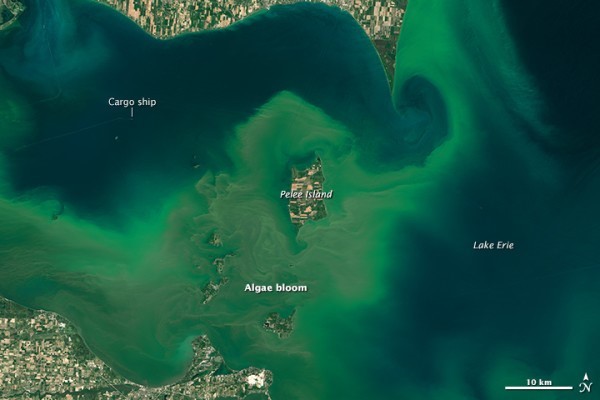Getting Mean with Green: WWF joins bi-national group in making key recommendations to reduce algae problem in Lake Erie
WWF-Canada’s vision is to have all Canadian waters in good health by 2025, and we have been keeping a close eye on threats to our Great Lakes. In our recent assessment of the Great Lakes watershed, as part of the Watershed Reports initiative, we found that pollution was a key threat within the region. Within the rivers and streams of the Northern Lake Erie sub-watershed water quality was observed to be below the desired state of “good condition”. In fact phosphorus levels exceeded water quality guidelines in more than 70 per cent of water samples taken between 2008 and 2012. This is quite alarming.
Phosphorus is a key nutrient in aquatic systems, but excess phosphorous is the leading cause of the increase in the harmful blue-green algae that is becoming more common in the Great Lakes. Toxic and harmful algal bloom occurrences in Lake Erie are caused, in large part, by excess phosphorus concentrations, and are among the top concerns for the Great Lakes, posing risks to drinking supplies, quality of life and economic vitality. Despite efforts over the years, the amount of algae has continued to increase in Lake Erie over the past decade.
One of the ways that WWF-Canada takes action is by working with other environmental non-profits as well as providing input to initiatives that affect our waters.
Recently, the Great Lakes Water Quality Agreement (GLWQA 2012) Nutrients Annex Subcommittee, a collaboration between Canadian and U.S. governments, released new phosphorous targets that recommended 40 per cent reduction in phosphorus loads entering Lake Erie’s central and western basins.
WWF-Canada reviewed the Subcommittee’s Recommended Binational Phosphorus Targets to Combat Lake Erie Algae Blooms and provided feedback in a joint, bi-national submission with groups including Freshwater Future, Freshwater Future Canada, Ohio Environmental Council, Environmental Defence and Alliance for the Great Lakes
Some of the highlights of that submission included the following recommendations:
- A 40 per cent reduction target be established for the eastern basin of Lake Erie, at least on an interim basis.
- Ensure science and research focus on determining the sources of phosphorous entering Lake Erie, focusing on priority tributaries.
- Set a clear date to achieve the targets. The Governors of Ohio and Michigan and the Premier of Ontario recently signed an agreement to achieve a 40 percent reduction of phosphorus loading into Lake Erie by 2025.
We appreciate the opportunity to provide input into this process, and we hope that with the additional measures and collaboration among partners and governments, we will begin to see improvements that will make a significant impact to the algae problem and help us achieve a healthy future for the Great Lakes.
To read more about algae blooms check out this blog.


